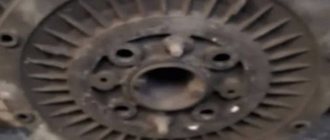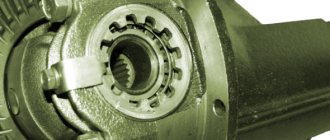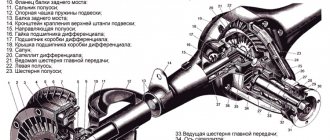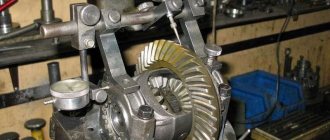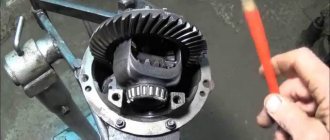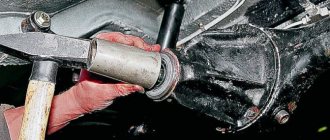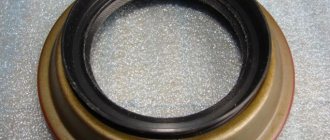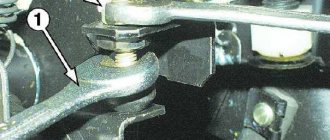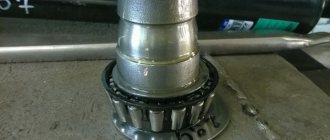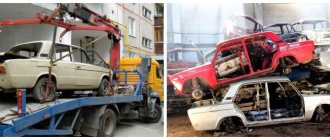All VAZ classic cars are rear-wheel drive, the vehicle moves using the rear axle, which is the drive axle. The VAZ rear axle gearbox is the most important part in the transmission; it is where the main gear is located.
A lot depends on the gearbox - if it is faulty and humming, the car can get stuck in the middle of the road at any moment and will have to be towed. The speed of the car depends on the gear ratio (TR) of the main pair in the rear axle gearbox (REA) - the lower it is, the faster the car will move. But too high a speed loads the engine and transmission, so when replacing REM, owners of VAZ 2101-07 vehicles need to take into account the power and volume of the internal combustion engine (ICE), and install a gearbox that optimally matches the technical characteristics of the vehicle.
Device
In order for the car to move, it is necessary to transfer the rotation of the engine to the wheels. But the engine speed is too high, and in order to correctly distribute the torque, a mechanism is needed that changes the gear ratio. Due to the gearbox and different engine speeds, the speed of movement changes, and the main pair of the rear axle takes over the rotation and transmits it to the wheels through gears.
The VAZ rear axle gearbox consists of the following parts:
- flange, it is fixed on the drive gear (shank) of the RZM, and is an intermediate link between the driveshaft and this gear;
- the shank of the main pair, at one end of which there are splines for pressing the flange, at the other end there is a bevel gear with a small number of teeth;
- driven gear (planet gear), it is in mesh with the drive gear, and it is with it that it forms the main gear;
- center differential, allowing the rear wheels to spin at different angular speeds.
The differential design is very simple - the mechanism consists of two axle gears, two satellites and a satellite pin. From the gearbox, the movement is transmitted to the axle shafts, on which the wheels are mounted.
Where is the gearbox located?
On the "sevens", as on all representatives of the rear-wheel drive family, the gearbox is located at the rear, under the bottom of the car. It connects the cardan to the VAZ 2107 axle and causes the wheels of the car to rotate. Rotation occurs thanks to axle shafts engaged in the gearbox, which, due to the technical features of the rear axle of the VAZ 2107, will have to be removed later. If the car is lifted, or when viewed from a garage pit, the gearbox is simply impossible not to notice.
Signs and malfunctions of the classic rear axle gearbox
Replacing a gearbox with your own hands is a labor-intensive process, which includes not only the purchase of a new unit (quite expensive), but also time costs. Therefore, before you start, you need to make sure that the gearbox is faulty. You can define the signs like this:
- gradually accelerating the car, listen carefully and remember at what moment the noise appears;
- while driving, start engine braking (remove your foot from the gas pedal at speed), at this time listen to the gearbox and note the moment the noise appears;
- accelerate the "seven" to hundreds, switch to neutral and turn off the engine - listen to how the gearbox behaves while coasting.
“If the bridge is noisy both in neutral and at speeds, the gearbox has nothing to do with it. If the hum occurs only at speed (regardless of the number), repairs, or, as a last resort, replacement of the gearbox are inevitable.”
When the signs are identified, it is necessary to carry out another check:
- park the car, secure the front wheels with shoes;
- jack up the rear so that the bridge hangs over (it is necessary that the wheels come off the surface);
- start the engine and accelerate the “seven” to the point at which noise occurs, while the wheels should spin without load.
If the noise has not changed, then the gearbox is clearly in good working order and it is not the cause of the trouble. Here other drive units are checked. Well, if there is no noise when driving without a load, then we are talking about worn gears of the gearbox, which make noise only when driving with a load.
Differences in VAZ rear axle gearboxes
RZMs differ in the gear ratio of the main pair; in total, there are four types of gearboxes on the VAZ classic:
- 2101;
- 2102;
- 2103;
The slowest one is the RZM 2102, its drive gear has 9 teeth, and the driven gear has 40 teeth. To calculate the gear ratio, you need to divide the number of planetary gear teeth by the number of teeth on the drive shaft; for the VAZ 2102 the drive gear is equal to 4.44.
The “penny” gearbox (2101) accordingly has the number of teeth on the gears 10/43, so its IF is 4.3. The next, faster one is RZM 2103 - it has a ratio of 10/41, which means the gear ratio is 4.1. And finally, the “fastest” will be the 2106 gearbox, with the number of teeth 11/43 and an inverter frequency of 3.9, respectively.
Many VAZ 2101-07 owners strive to install the fastest gearbox, but this is not always necessary. If the car often carries cargo, that is, the car is a “workhorse”, high speed is of no use, but high-torque power will be very useful. It should be noted that RZM 2102 was not supplied as spare parts; it was installed only on station wagons.
Replacing the rear axle gearbox of VAZ 2106, 2107
The main disease of REM is increased noise (hum), and the gearbox can hum for various reasons:
- there is insufficient oil in the bridge, or it is completely missing;
- the gap between the gears of the main pair is not adjusted;
- the gears are worn out, they have chips and other damage;
- the main pair has a manufacturing defect, the gears are not ground in from the factory;
- the shank nut has become unscrewed or loosened;
- bearings are worn out.
The main malfunction of the center differential is the wear of the gears of the axle shafts and satellites, when the surfaces of the parts are heavily worn, play forms between the differential gears, but the rear axle usually does not make noise due to wear of the differential gears.
ZM gearboxes on VAZ classics can be repaired, but only if there is no wear on the gears. If the mechanism can no longer be repaired, it needs to be replaced. We replace the rear axle gearbox of a VAZ 2106 on a “seven” as follows:
- we install the car on a pit or a car lift; changing the gearbox on the ground is extremely inconvenient;
- if the car is installed on a pit, it is necessary to jack up both sides; in any case, the rear wheels must be removed. If the work is not done on a lift, you should install stops under each side of the car (in the rear);
- unscrew the drain plug in the REM, drain the transmission oil, having previously prepared a container for it;
- remove the rear brake drums (two guide bolts on each side), after first removing the car from the handbrake. The drums can be difficult to remove; they are dismantled by tapping them from behind with a hammer through a wooden block. You cannot hit the drum with a metal hammer; the drum may break;
- remove the brake pads;
- unscrew the fastenings of the rear axle axle shafts on each side, each axle shaft is secured with four nuts;
- we press out the axle shafts, for this you will need a special puller, you can also make a homemade device;
- remove the driveshaft by unscrewing the four bolts and nuts. If the same REM is installed, the cardan with the shank must be marked; this is done in order to put the shaft back in the same position. If you install the cardan incorrectly according to the marks, the shaft may begin to vibrate;
- unscrew the eight bolts securing the rear gearbox (key 13), remove the assembly.
At this point, the removal of the gearbox can be considered complete; now all that remains is to either repair the mechanism or install a new one instead.
Signs of gearbox problems
The rear gearbox is one of the reliable mechanisms of classic Zhiguli cars and breakdowns rarely occur with it. However, like any other unit, it may have its own malfunctions, which are determined by characteristic symptoms. They are worth dwelling on in more detail.
Noise when accelerating
If during acceleration there is an extraneous sound from the gearbox installation site, then it can be caused by:
- worn out or incorrectly adjusted differential bearings. It will require dismantling, disassembling and diagnosing parts with subsequent adjustment;
- Incorrect meshing of the teeth of the main pair gears. Eliminated by proper adjustment;
- lack of lubrication in the gearbox. The lack of oil in the crankcase is restored, after which it is checked for leaks at the places where the sealing elements are installed.
Axle bearings are not a structural element of the gearbox, but if the part fails, then an extraneous sound may also be observed during acceleration.
Noise when accelerating and braking the engine
If noise occurs both during acceleration and during braking by the power unit, there may not be many reasons:
- deterioration or failure of the bevel gear bearings of the main pair. Eliminated by replacing failed elements;
- Incorrect adjustment of the gap between the tip and the planetary gear. The mechanism needs to be diagnosed and replaced with damaged parts, as well as setting the required gap between the gear teeth.
Video: how to determine the source of noise in the rear axle
Knocking, crunching noise when moving
If the gearbox begins to make sounds uncharacteristic of its normal operation, then it will be possible to accurately diagnose the breakdown only after disassembling the unit. The most likely causes of a crunching or knocking sound may be:
- tooth breakage on the gears of the main pair;
- great wear of the main pair;
- Problems or incorrect adjustment of the bevel gear bearings.
Noises when turning
Noise in the gearbox is also possible when turning the car. The main reasons for this phenomenon may be:
- tight rotation of the satellites or the appearance of scratches on their surface. Eliminated by replacing damaged parts or treating roughness with sandpaper. If the defect cannot be removed, the failed parts must be replaced;
- jamming of side gears. If the gears have barely noticeable damage, clean them with sandpaper. Elements with signs of heavy wear are replaced with new ones;
- The gap between the differential gears is set incorrectly. It is necessary to set the correct gap between the gears;
- defective semi-axial bearings. The ball bearings need to be replaced with new ones.
Knock when starting to move
The appearance of a knock in the rear gearbox of a VAZ 2106 at the beginning of movement may be accompanied by:
- large gap between the splines of the bevel gear shaft and the flange. It is necessary to inspect the condition of both parts. If significant wear is detected on the splines, the elements are replaced;
- increased gap between the teeth of the main pair gears. The problem is “cured” by adjusting the gap;
- large amount of space for the pinion axle in the differential box. The box needs replacing;
- The fastening of the reaction rods of the rear beam has become loose. It is necessary to inspect and tighten the fastening.
Gearbox jammed
Sometimes the REM may jam, i.e. torque will not be transmitted to the drive wheels. The reasons that can lead to such a malfunction are as follows:
- lack of lubricant in the mechanism, which could leak due to leakage of the unit;
- failure of satellites;
- damage to the bearing on the bevel gear of the main pair.
Lack of lubrication in the gearbox leads to increased production and jamming of the mechanism
If one wheel is stuck, the problem may be related to the brake mechanism or axle bearing.
Oil leakage can be determined without disassembling the gearbox, but other faults cannot be identified without this procedure. If, after disassembly, scuffs, broken teeth or visible damage to the bearing are found on the gears, then the parts need to be replaced.
Oil leak
Lubricant leakage from the “six” gearbox is possible for two reasons:
- failure of the shank oil seal;
- damage to the gasket between the gearbox and the rear axle stocking.
To accurately determine where the oil is leaking from, you need to wipe off the lubricant with a rag and after a while inspect the gearbox: the location of the leak will be noticeable. After this, you can take further actions - remove the entire gearbox to replace the gasket, or dismantle only the cardan and flange to replace the lip seal.
An oil leak is indicated by a wet gearbox in the lower part.
Defects in the gearbox
Increased play in the RZM can be formed due to wear of the differential pinion pin - if you grab the driveshaft and rotate it clockwise and counterclockwise, this play can be felt. Also, increased clearance can be formed due to wear of the splines inside the differential housing itself.
If the gaps in the main pair of gearboxes are not adjusted, a characteristic noise occurs when the car moves:
- when the load increases (sharp acceleration), a characteristic howl is heard in the bridge;
- When I let off the gas the noise goes away.
The engine can hum in a different way, but the characteristic feature described above can most often be heard on VAZ classic cars. Worn teeth of the main pair are clearly visible on the planetary gear - they become rounded, and they often show traces of rust.
Diagnostics and causes of malfunctions
The fact that the gearbox is in a faulty condition is indicated by the appearance of a characteristic noise (hum) when the vehicle is moving. To accurately determine the gearbox malfunction, there is the following experiment.
You need to accelerate the car to 25 kilometers per hour and gradually pick up speed, starting from this mark. If suspicious hums appear, be sure to record the speed at which you hear them.
Once you reach the desired speed, slowly release the gas pedal and apply engine braking. Again, listen for extraneous noises and pay attention to the speed at which they appear or disappear.
Certain noises should appear and disappear at the same speed. If this happens, it means that the rear axle gearbox is in a faulty condition. However, to be 100 percent sure, be sure to put the car on the parking brake, put the gear in neutral and try to gain speed, if the noise appears again, then the problem is not in the rear axle gearbox, and if there is no noise, then you can be sure that it is rear axle gearbox.
The cause of malfunctions, most often, lies in the use of low-quality oil, loss of its viscosity, as well as its complete absence. In addition, the gearbox may fail due to failure of oil seals, bearings and special gears. Sometimes, the cause of a rear axle gearbox failure is a broken axle shaft.
Adjusting the VAZ rear axle gearbox
If the main pair in the gearbox is worn out, it must be replaced. But you can’t just put the gears back in place; the gaps in them must be adjusted. In total, two types of basic adjustments are made:
- The thickness of the adjusting sleeve (washer) is selected for the shank (drive gear). The washer can have a thickness from 2.6 mm to 3.5 mm;
- The gap between the gears of the main pair is adjusted using two adjusting nuts of the differential housing.
The washer for the shank is selected in such a way that the shaft with the drive bevel gear rotates in the gearbox housing without backlash with a force by hand (0.3-0.4 kg). In this case, the shank nut should be tightened with a force of 12 to 26 kg, usually 18-19 kg are tightened.
After installing the shank, the differential housing with the planetary gear attached to it is put in place. The housing is secured with two covers (4 bolts, a knob with a 17mm head). The adjusting nuts are tightened from the sides of the bearings, the differential is installed so that there is play between the gears of the main pair, and the planetary gear should not be clamped. By moving the adjusting nuts to the right and left, the shank gear is brought to the planetary gear. By adjusting, you select the moment when the gap between the gears practically disappears.
The last stage is to adjust the preload of the differential bearings; the adjusting nuts are tightened from the sides. This work must be done with an indicator; the device should show from 0.14 to 0.18 mm, the gap between the gears should be within 0.08-0.13 mm. After the operation, the adjusting nuts are fixed with plates so that they do not turn.
It should be noted that adjusting the VAZ rear axle gearbox is a very difficult matter, and it is better to trust it to professionals.
AUTOFIZIK.RU / auto repair
We assemble the main gear in the reverse order of disassembly, lubricating the bearings and gears with transmission oil.
Having installed the drive gear in the gearbox housing,... ...with a torque wrench, tighten the flange nut with a torque of 16–20 kgf.m, while the gear must be rotated for proper installation of the rollers in the bearings.
We install an indicator with a division value of no more than 0.01 mm on a tripod, resting its leg against the end of the flange...
...and moving the shaft by the flange, we measure the axial play of the drive gear.
To eliminate play, remove the spacer ring installed on the gear shaft (see Dismantling the rear axle) and measure its thickness with a micrometer. We select and install a new spacer ring. It should be thinner than the amount of play removed and additionally thinner by 0.05 mm - if the drive gear bearings are new or by 0.01 mm - if the bearings are left the same. If there is no axial play of the drive gear, use a special torque wrench with a scale of up to 0.5 kgf.m to check the moment of resistance to shaft rotation. With proper adjustment, the resistance moment should be 15–20 kgf.cm for new bearings or 7–10 kgf.cm if the bearings are left the same. With sufficient accuracy, the moment of resistance can be measured using a household steelyard...
...hooking its hook onto the hole in the flange.
In this case, the required values will be less - 3.8–5 kgf and 1.8–2.5 kgf, respectively. If the moment of resistance is greater, we change the spacer ring to another one, 0.01–0.02 mm thicker; if it is less, we select a ring of smaller thickness accordingly. Before assembly, the bolts for fastening the parts of the differential box and the bolts for fastening the driven gear, as well as their threaded holes, are degreased and coated with anaerobic sealant. We pay special attention to the cleanliness of the end mounting surfaces of the gears and the gearbox; the slightest contamination or nicks are unacceptable.
When installing the driven gear on the gearbox, we center it using long M10×1 bolts (you can use bolts from old connecting rods).
When installing the driven gear on the gearbox, we center it using long M10×1 bolts (you can use bolts from old connecting rods). Using adjusting nuts, we tighten the differential bearings with a slight tension, while turning the gear in one direction or the other so that the bearing rollers take the correct position.
To measure the lateral clearance in the meshing of the final drive gears, we attach an indicator to the rear axle housing by moving its probe to the top of the tooth on the outside of the driven gear.
The gap should be 0.15–0.20 mm. Measurements should be repeated on at least six teeth in opposite zones of the crown. To reduce the gap (using a screwdriver or a thin steel rod), loosen the adjusting nut on the side opposite the driven gear and tighten the other. You need to unscrew one nut and tighten the other by the same amount, guided by the grooves of the adjusting nuts. In this case, each unscrewing of the adjusting nut must be completed by tightening it slightly. For example, to loosen a nut by five grooves, unscrew it by six, and then tighten it by one groove. This will ensure that the bearing outer race is in constant contact with the nut and thus ensures that it remains in place during operation. To increase the gap, repeat the entire procedure in reverse order. After adjusting the lateral clearance in the engagement, we check the axial play in the differential bearings, for which:
...we fix the indicator on a tripod, resting its probe against the end of the driven gear. By rocking the gear in the axial direction, we measure the play in the differential bearings.
Using an adjusting nut located on the opposite side of the driven gear, we set the axial play to 0.035–0.055. Next, by tightening the nut, we set the bearing preload: 0.1 – when the bearing mileage is less than 10 thousand km; 0.05 – with a mileage of more than 10 thousand km. Turning the nut one notch corresponds to “compressing” the bearing by 0.03 mm. Once adjusted, tighten the bearing cap bolts and install the locking plates (see Rear Axle Disassembly) and check the side clearance again.
ATTENTION Before final tightening of the cover bolts, turn them out one by one and apply anaerobic sealant to the threaded part.
Adjusting the final drive according to the contact patch of the teeth is an effective way to adjust the gear mesh. It also allows you to check the quality of adjustments made by other methods.
Apply paint, preferably bright paint, to the teeth of the driven gear.
We turn the drive gear flange several times in both directions, while simultaneously slowing down the driven gear until the paint wears off at the points where the teeth contact. We inspect the contact spots on the driven gear teeth from the convex and concave sides. If the contact patch is located at the top of the teeth, it is necessary to increase the thickness of the adjusting ring at the drive gear, and if at the base, reduce it. If the contact patch is shifted to the center of the gear, it is necessary to increase the gap between the driven and driving gears, and if outward, reduce it. After adjustment, we install the gearbox in the rear axle, while applying a thin layer of oil-resistant sealant to the mounting bolts and flange. Having assembled the rear axle and filled it with oil (see Changing the oil in the gearbox), we test the gearbox on the move. To do this, we travel at a speed of 60–70 km/h for 20–30 minutes. The temperature of the crankcase neck should not be higher than 95° (water drops should not boil). Otherwise, it is necessary to reduce the preload of the pinion bearings.
Contact patch in final drive gears
A – forward sides; B – reverse sides;
1 – correct location of the contact patch;
2 – the contact patch is located at the top of the tooth – to correct it, move the drive gear towards the driven gear;
Repair or replacement, which is better?
Car owners of VAZ classics often cannot decide what is best to do - buy a complete ready-made REM assembled or purchase individual parts and repair the gearbox. It’s really difficult to decide here - the price of a new gearbox, of course, is higher, but the owner of the car is freed from the headache of adjustment. The thing is that it’s not so easy to find a good specialist in VAZ gearboxes, and there is no guarantee that the new main pair will not hum.
If a car owner buys a new gearbox, but it hums, the part can be exchanged under warranty, but the car owner loses money on removing and installing the gearbox. If you purchase a defective main pair, the repair itself will be more expensive - you will have to pay a technician for a secondary overhaul of the gearbox.
When and how does the gearbox hum if the bearings are worn out?
If the VAZ gearbox howls constantly, regardless of the driving mode, and the sound resembles a buzzing, there is most likely a problem with the bearings. Moreover, we can say with confidence that the parts on which the drive shaft of the gearbox rotates have exhausted their service life. The fact is that the roller bearings of the shank rotate about 5 times faster than the axle shafts and satellites, and wear out faster. Another reason for accelerated wear is an overtightened shank nut. If the gearbox hums not very melodiously, the sound is more like a crunching sound - the problem should be looked for elsewhere. This is usually how a malfunction of the differential bearings or axle shafts makes itself known. You can verify this by listening to a car with the drive wheels hanging out. The operation should be performed in a viewing hole or on a lift.
VAZ rear axle gearbox locking
On VAZ 2101-07 vehicles, the factory does not provide locking of the center differential, but the industry already produces both differentials with locks and fully assembled 3M gearboxes. The most common today are REMs with screw locking; in them, the differential gears are locked depending on the load. In such rear axle gearboxes, a preload clutch is installed, it connects the wheel axle shafts with a certain force, and acts as a blocker.
Locking the VAZ rear axle gearbox provides the following advantages:
- increases cross-country ability, allows the vehicle to avoid slipping on difficult road sections;
- allows the car to accelerate faster at the start;
- The car corners more confidently.
But ZM gearboxes with screw locking also have their disadvantages:
- Fuel consumption increases slightly;
- when accelerating, the car handles worse;
- The differential and assembled gearbox with locking are much more expensive than standard parts (the price is approximately 2-2.5 times higher).
VAZ 2101-07 car owners should know that after installing the RZM with blocking, the car will not become an SUV, and it will not be able to move on severe off-road conditions.
Related articles:
- How to deal with self-discharge of a car battery The condition of the battery determines how stably the engine will start and whether all electricity consumers will be able to operate uninterruptedly. Situations often arise when [...]
- Engines installed on the Opel Corsa D car Since the car is small in size, the Opel Corsa does not require a large engine, however, for dynamic driving a certain reserve […]
- Advantages and disadvantages of the VAZ-11113 Oka The subcompact compact car VAZ 11113 “Oka” is somewhat unique - there are practically no such miniature cars in Russia anymore. With its technical characteristics [...]
Purpose and principle of operation of the gearbox
The rear gearbox of the “seven” is a transmission link between the axles of the rear wheels and the engine. Its purpose is to transmit torque from the engine crankshaft to the rear wheels while simultaneously converting the rotation speed of the axle shafts.
In addition, the gearbox must be able to distribute torque depending on the load applied to the left or right wheel.
Principle of operation
Here are the main stages of transmitting torque from the motor to the gearbox:
- the driver starts the engine and the crankshaft begins to rotate;
- from the crankshaft, torque is transmitted to the car’s clutch discs, and then goes to the input shaft of the gearbox;
- when the driver selects the desired gear, the torque in the gearbox is transferred to the secondary shaft of the selected gear, and from there to the driveshaft connected to the gearbox with a special crosspiece;
- the cardan is connected to the rear axle gearbox (since the rear axle is located far from the engine, the “seven” cardan is a long rotating pipe with crosses at the ends). Under the action of the cardan, the main gear shaft begins to rotate;
- rotating, the gearbox distributes torque between the axle shafts of the rear wheels, as a result the rear wheels begin to rotate.
